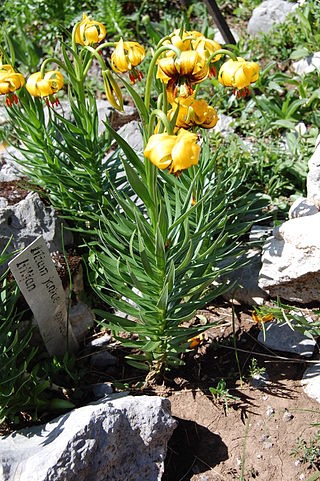Top Qs
Timeline
Chat
Perspective
Lilium bosniacum
Species of lily From Wikipedia, the free encyclopedia
Remove ads
Lilium bosniacum is a lily native to Bosnia and Herzegovina. It is also known as zlatni ljiljan (Bosnian for golden lily) and Bosanski ljiljan (Bosnian lily).
L. bosniacum has often been lumped and split and lumped again. Some results of molecular studies[1] support it as an infraspecific taxon of Lilium carniolicum. Lilium bosniacum, together with Lilium albanicum and Lilium jankae have been treated as varieties of Lilium carniolicum.
However, extensive DNA-analyses[2][3] have shown that this group is polyphyletic.
Remove ads
Description
Lilium bosniacum Beck ex Fritsch 1909 Section 3b Syn.: L. carniolicum var. bosniacumno
Bulb: ovoid, 6–7 cm in diameter, yellowish.
Stem: 30–90 cm.
Leaves: densely scattered, horizontal with tips curved upwards, narrowly lanceolate with slightly hairy margins.
Flowers: 1–6 in a raceme, nodding, fragrant. Tepals strongly revolute, typical Turk's cap-shape, wax-like texture, yellow to orange without spots, ~6 cm in diameter. Seeds with delayed hypogeal germination. Flowering time ~July. 2n=24.
Origin: Bosnia and Herzegovina.
Remove ads
Symbolic use
Summarize
Perspective

The fleurs-de-lis was the symbol of the House of Kotromanić, a ruling house in medieval Bosnia during the medieval Kingdom of Bosnia, adopted by the first Bosnian king, Tvrtko I, in recognition of his ancestral lineage of Kingdom of Serbia Nemanjić dynasty[4] and the Capetian House of Anjou support in assuming the throne of Bosnia. The coat of arms contained six fleurs-de-lis,[5] where the flower itself is today often considered to be a representation of the autochthonous golden lily, Lilium bosniacum.[6]
The emblem was revived in 1992 as a national symbol of the Republic of Bosnia and Herzegovina and was part of the flag of Bosnia-Herzegovina from 1992 to 1998.[6][5] The state insignia were changed in 1999. The former flag of the Federation of Bosnia and Herzegovina contains a fleur-de-lis alongside the Croatian chequy. Fleurs also appear in the flags and arms of many cantons, municipalities, cities and towns. Today, it is a traditional symbol of the Bosniak people.[7][8] It is still used as official insignia of the Bosniak Regiment of the Armed Forces of Bosnia and Herzegovina.[9]
Fleurs-de-lis today also appear in the flags and arms of many cantons, municipalities, cities and towns of Bosnia and Herzegovina.
Coat of arms of the Kingdom of Bosnia (1377–1463)
Coat of arms of Republic of Bosnia and Herzegovina
Remove ads
See also
References
Wikiwand - on
Seamless Wikipedia browsing. On steroids.
Remove ads



